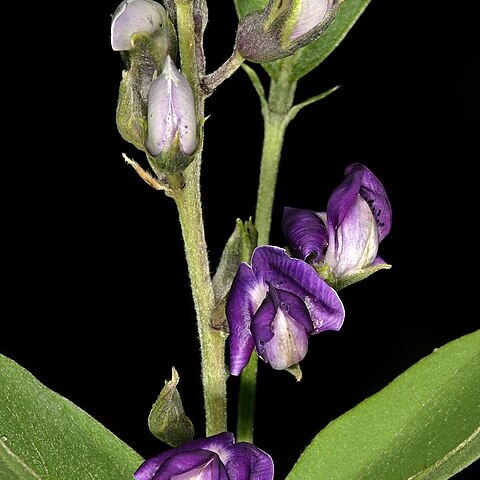Subshrubby herb, erect, climbing, scrambling or entirely prostrate, 0.9-2.4(10.8) m long; rootstock tuberous, often conical, frequently exceeding 40 cm in width. Stems glabrous to velvety, sometimes flowering just before the leaves are fully expanded. Leaflets 3, very rarely 4-5, 5-18.5(21) x 4-18.5 cm, ovate, oblong or almost round in outline, from entire with every gradation to deeply 3-lobed, often resembling those of the edible fig tree, the lobes triangular-ovate to oblong or subspathulate, acute, acuminate, truncate or even emarginate; mucronulate, glabrescent to densely velvety; petioles 2.5-26 cm long; rhachis 1-9 cm long; petiolules 3-8 mm long; stipules 0.5-1.3 cm x 2-4 mm, linear-lanceolate. Inflorescences rather dense, many-flowered; rhachis 7-34 cm long; peduncle 4-20 cm long; pedicels 2-6(8) mm long; bracts (3)6.5-8 x 2-2.7 mm, ovate-lanceolate. Calyx appressed pubescent; tube 3-4 mm long; lobes 3-6 mm long. Standard greyish-violet to greenish-white outside, mauve or bluish-violet with green centre inside, 1-1.2 x 1-1.3 mm, oblate or transversely oblong; wings mauve or bluish-violet, white at the base; keel pale violet, white at the base, or greenish tinged mauve. Pods rather swollen, 6.3-10.8(13) x 1-1.8(2.2) cm, (1)4-6-seeded, densely covered with appressed pale ferruginous sometimes silky, rarely more stiff, hairs. Seeds black or very dark blackish-red, 8-10 x 6-8 x 4-5.5 mm.
Leaflets 3, very rarely 4–5, 5–18.5(21) × 4–18.5 cm, ovate, oblong or almost round in outline, from entire with every gradation to deeply 3-lobed, often resembling those of the edible fig tree, the lobes triangular-ovate to oblong or subspathulate, acute, acuminate, truncate or even emarginate; mucronulate, glabrescent to densely velvety; petioles 2.5–26 cm long; rhachis 1–9 cm long; petiolules 3–8 mm long; stipules 0.5–1.3 cm × 2–4 mm, linear-lanceolate.
A small shrubby herb. It can be erect, climbing or scrambling. The stems can be 2 m long. It has a large tuberous rootstock. It keeps growing from year to year. Annual shoots develop from the large tuber. The leaves are hairy and have lobes. The flowers are bright blue. There are a very large tuber or root stock.
Standard greyish-violet to greenish-white outside, mauve or bluish-violet with green centre inside, 1–1.2 × 1–1.3 mm, oblate or transversely oblong; wings mauve or bluish-violet, white at the base; keel pale violet, white at the base, or greenish tinged mauve.
Subshrubby herb, erect, climbing, scrambling or entirely prostrate, 0.9–2.4(10.8) m long; rootstock tuberous, often conical, frequently exceeding 40 cm in width.
Inflorescences rather dense, many-flowered; rhachis 7–34 cm long; peduncle 4–20 cm long; pedicels 2–6(8) mm long; bracts (3)6.5–8 × 2–2.7 mm, ovate-lanceolate.
Pods rather swollen, 6.3–10.8(13) × 1–1.8(2.2) cm, (1)4–6-seeded, densely covered with appressed pale ferruginous sometimes silky, rarely more stiff, hairs.
Stems glabrous to velvety, sometimes flowering just before the leaves are fully expanded.
Calyx appressed pubescent; tube 3–4 mm long; lobes 3–6 mm long.
Seeds black or very dark blackish-red, 8–10 × 6–8 × 4–5.5 mm.

